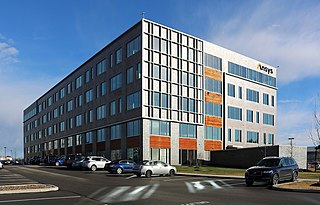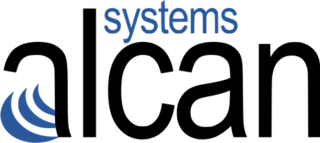Related Research Articles

DESY, short for Deutsches Elektronen-Synchrotron, is a national research centre for fundamental science located in Hamburg and Zeuthen near Berlin in Germany. It operates particle accelerators used to investigate the structure, dynamics and function of matter, and conducts a broad spectrum of interdisciplinary scientific research in four main areas: particle and high energy physics; photon science; astroparticle physics; and the development, construction and operation of particle accelerators. Its name refers to its first project, an electron synchrotron. DESY is publicly financed by the Federal Republic of Germany and the Federal States of Hamburg and Brandenburg and is a member of the Helmholtz Association.

Computational physics is the study and implementation of numerical analysis to solve problems in physics. Historically, computational physics was the first application of modern computers in science, and is now a subset of computational science. It is sometimes regarded as a subdiscipline of theoretical physics, but others consider it an intermediate branch between theoretical and experimental physics — an area of study which supplements both theory and experiment.

Computer-aided engineering (CAE) is the general usage of technology to aid in tasks related to engineering analysis. Any use of technology to solve or assist engineering issues falls under this umbrella.

The Technische Universität Darmstadt, commonly known as TU Darmstadt, is a research university in the city of Darmstadt, Germany. It was founded in 1877 and received the right to award doctorates in 1899. In 1882, it was the first university in the world to set up a chair in electrical engineering. In 1883, the university founded the first faculty of electrical engineering and introduced the world's first degree course in electrical engineering. In 2004, it became the first German university to be declared as an autonomous university. TU Darmstadt has assumed a pioneering role in Germany. Computer science, electrical engineering, artificial intelligence, mechatronics, business informatics, political science and many more courses were introduced as scientific disciplines in Germany by Darmstadt faculty.
The boundary element method (BEM) is a numerical computational method of solving linear partial differential equations which have been formulated as integral equations, including fluid mechanics, acoustics, electromagnetics, fracture mechanics, and contact mechanics.

Finite-difference time-domain (FDTD) or Yee's method is a numerical analysis technique used for modeling computational electrodynamics. Since it is a time-domain method, FDTD solutions can cover a wide frequency range with a single simulation run, and treat nonlinear material properties in a natural way.

Ansys, Inc. is an American multinational company with its headquarters based in Canonsburg, Pennsylvania. It develops and markets CAE/multiphysics engineering simulation software for product design, testing and operation and offers its products and services to customers worldwide.

Computational electromagnetics (CEM), computational electrodynamics or electromagnetic modeling is the process of modeling the interaction of electromagnetic fields with physical objects and the environment using computers.
Dassault Systèmes Simulia Corp. is a computer-aided engineering (CAE) vendor. Formerly known as Abaqus Inc. and previously Hibbitt, Karlsson & Sorensen, Inc., (HKS), the company was founded in 1978 by David Hibbitt, Bengt Karlsson and Paul Sorensen, and has its headquarters in Providence, Rhode Island.

Computational Engineering is an emerging discipline that deals with the development and application of computational models for engineering, known as Computational Engineering Models or CEM. Computational engineering uses computers to solve engineering design problems important to a variety of industries. At this time, various different approaches are summarized under the term Computational Engineering, including using computational geometry and virtual design for engineering tasks, often coupled with a simulation-driven approach In Computational Engineering, algorithms solve mathematical and logical models that describe engineering challenges, sometimes coupled with some aspect of AI, specifically Reinforcement Learning.

OpenFOAM is a C++ toolbox for the development of customized numerical solvers, and pre-/post-processing utilities for the solution of continuum mechanics problems, most prominently including computational fluid dynamics (CFD).
Abaqus FEA is a software suite for finite element analysis and computer-aided engineering, originally released in 1978. The name and logo of this software are based on the abacus calculation tool. The Abaqus product suite consists of five core software products:
- Abaqus/CAE, or "Complete Abaqus Environment". It is a software application used for both the modeling and analysis of mechanical components and assemblies (pre-processing) and visualizing the finite element analysis result. A subset of Abaqus/CAE including only the post-processing module can be launched independently in the Abaqus/Viewer product.
- Abaqus/Standard, a general-purpose Finite-Element analyzer that employs implicit integration scheme (traditional).
- Abaqus/Explicit, a special-purpose Finite-Element analyzer that employs explicit integration scheme to solve highly nonlinear systems with many complex contacts under transient loads.
- Abaqus/CFD, a Computational Fluid Dynamics software application which provides advanced computational fluid dynamics capabilities with extensive support for preprocessing and postprocessing provided in Abaqus/CAE - discontinued in Abaqus 2017 and further releases.
- Abaqus/Electromagnetic, a Computational electromagnetics software application which solves advanced computational electromagnetic problems.
Feko is a computational electromagnetics software product developed by Altair Engineering. The name is derived from the German acronym "Feldberechnung für Körper mit beliebiger Oberfläche", which can be translated as "field calculations involving bodies of arbitrary shape". It is a general purpose 3D electromagnetic (EM) simulator.
Peter Peet Silvester was an electrical engineer who contributed to understanding of numerical analysis of electromagnetic fields and authored a standard textbook on the subject.
A charged particle accelerator is a complex machine that takes elementary charged particles and accelerates them to very high energies. Accelerator physics is a field of physics encompassing all the aspects required to design and operate the equipment and to understand the resulting dynamics of the charged particles. There are software packages associated with each domain. The 1990 edition of the Los Alamos Accelerator Code Group's compendium provides summaries of more than 200 codes. Certain codes are still in use today, although many are obsolete. Another index of existing and historical accelerator simulation codes is located at the CERN CARE/HHH website.
Ulrich Jakobus is Senior Vice President - Electromagnetic Solutions of Altair, Germany and was awarded Fellow of the Institute of Electrical and Electronics Engineers (IEEE) in 2013 for leadership in hybrid computational tool development and commercialization. His research laid the foundations for the commercial electromagnetics code FEKO which is used in antenna design, antenna placement, electromagnetic compatibility, microwave components, bioelectromagnetics, radar cross section and related fields.

ALCAN Systems GmbH is a telecommunications company based in Darmstadt, Germany. The company is develops antenna systems for fixed, mobile, cellular and satellite-communication.
Computational materials science and engineering uses modeling, simulation, theory, and informatics to understand materials. The main goals include discovering new materials, determining material behavior and mechanisms, explaining experiments, and exploring materials theories. It is analogous to computational chemistry and computational biology as an increasingly important subfield of materials science.

Ursula van Rienen is a German applied mathematician and physicist whose research involves computational electrodynamics, the computational simulation of interactions between electromagnetic fields and biological tissue, and its applications in electrical brain stimulation. She is a university professor in the Institut für Allgemeine Elektrotechnik at the University of Rostock, where she holds the Chair of Electromagnetic Field Theory.
References
- 1 2 3 4 "Die Mitglieder der Akademie und der Jungen Akademie | Prof. Dr.-Ing. Thomas Weiland". Akademie der Wissenschaften und der Literatur Mainz (in German). Retrieved 2023-06-21.
- ↑ "Liste der mit dem Gottfried Wilhelm Leibniz-Preis Ausgezeichneten" (PDF). Deutsche Forschungsgemeinschaft (DFG) (in German). Retrieved 2023-06-21.
- ↑ "MTT Society News: Newly elevated fellows" (PDF). IEEE Microwave Magazine. 13 (2). IEEE: 94–95. March 12, 2012. doi:10.1109/MMM.2011.2181670. ISSN 1557-9581 . Retrieved 2023-06-21– via IEEEXplore.
- 1 2 3 "Staff at TEMF | Prof. Dr.-Ing. Thomas Weiland". Institute for Accelerator Science and Electromagnetic Fields (TEMF). Technical University of Darmstadt. Retrieved 2023-06-21.
- ↑ "Tonmodulierte Hochfrequenz als Signalträger elektronisch chiffrieren und dechiffrieren". jugend forscht | Projektdatenbank (in German). Stiftung Jugend forscht e. V. 1968. Retrieved 2023-06-21.
- ↑ "Mathematisch-elektronisches Chiffriersystem zur geheimen Nachrichtenübermittlung". jugend forscht | Projektdatenbank (in German). Stiftung Jugend forscht e. V. 1969. Retrieved 2023-06-21.
- ↑ "Entwicklung und Bau eines billigen Präzisions-Frequenzmessers sowie einer automatischen Oszillographenschaltung". jugend forscht | Projektdatenbank (in German). Stiftung Jugend forscht e. V. 1970. Retrieved 2023-06-21.
- ↑ Voss, G. A. & Weiland, T. (April, 1982). "Particle acceleration by wake fields" [Internal report No. M-82-10, unpublished]. Deutsches Elektronen-Synchrotron (DESY), Hamburg, Germany: pp. 1-21. DESY Publications Database, retrieved 2023-06-27.
- ↑ Voss, G. A. & Weiland, T. (1982). "The wake field acceleration mechanism" [Conference paper]. Proceedings of the ECFA-RAL topical meeting: The challenge of ultra-high energies, invited. Oxford, England, September 27–30, 1982: pp. 287–308. Fermilab Technical Publications, retrieved 2023-06-27.
- ↑ Bialowons, W., Bremer H. D., Decker, F. J., Lewin, H. C., Voss, G. A., Schütt, P., Weiland, T. & Xiao C. (1987). "The wake field transformer experiment at DESY" [Conference paper]. ECFA - CAS/CERN - IN2P3 - IRF/CEA - EPS workshop on new developments in particle acceleration techniques [Conference report, October 12, 1987]. S. Turner (ed.). Vol. 1. Orsay, France, June 29 - July 4, 1987: pp. 298-307. CERN document server, retrieved 2023-06-27.
- 1 2 "GSC 233: Graduate School of Computational Engineering". GEPRIS - Geförderte Projekte der DFG. Deutsche Forschungsgemeinschaft. Retrieved 2023-06-22.
- ↑ "Graduate-School-CE". Computational Engineering at the Technical University of Darmstadt. Retrieved 2023-06-22.
- ↑ "Publications - Thomas Weiland". TUbiblio. Technical University of Darmstadt. Retrieved 2023-06-22.
- ↑ Weiland, Thomas. "A discretization model for the solution of Maxwell's equations for six-component fields" (1977).International Journal of Electronics and Communications (former AEÜ - Archiv für Elektronik und Übertragungstechnik). Hirzel. Volume 31, Issue 3: pp. 116-120. ISSN 1434-8411
- 1 2 3 Johnston, Hamish (May 26, 2009). "Electromagnetic software accelerates ahead". Physics World. IOP Publishing. Retrieved 2023-06-27.
- ↑ Weiland, Thomas (1985). "Computer modelling of two- and three-dimensional cavities" [Conference paper]. 11th Particle Accelerator Conference: Accelerator Engineering and Technology. Vancouver, Canada, May 13–16, 1985: pp. 1-5. DESY Publications Database, retrieved 2023-06-27.
- ↑ Klatt, R., Krawczyk, F., Novender, W. R., Palm, C. & Weiland, T. [DESY], Steffen, B. [Kernforschungsanlage Jülich], Barts, T., Browman, M. J., Cooper, R., Mottershead C. T., Rodenz, S.G. [Los Alamos National Laboratory] (1986). "MAFIA - a three-dimensional electromagnetic CAD system for magnets, RF structures, and transient wakefield calculations" [Conference paper]. 13th International Linear Accelerator Conference, Stanford, USA, January 2–6, 1986: pp. 14-16: DESY Publications Database, retrieved 2023-06-27.
- 1 2 Ludwig, Astrid (July 17, 2018). "Millionenspenden als Dank für akademische Freiheit". Frankfurter Allgemeine Zeitung (in German) (163): 32. ISSN 0174-4909.
- 1 2 "Dassault Systèmes Completes CST Acquisition". Business Wire. October 3, 2016. Retrieved 2023-06-27.
- ↑ "Firmenbekanntmachungen | CST - Computer Simulation Technology GmbH, Darmstadt". North Data (in German). Retrieved 2023-06-27.
- ↑ "Firmenbekanntmachungen | ACE - Advanced Computational Engineering GmbH". North Data (in German). Retrieved 2023-06-27.
- ↑ "ACE GmbH - About". ace-gmbh.biz. Retrieved 2023-06-30.
- ↑ "Firmenbekanntmachungen | ALCAN Systems GmbH, Darmstadt". North Data (in German). Retrieved 2023-06-27.
- ↑ "ALCAN Systems | About - Board members". ALCAN Systems. Retrieved 2023-06-27.
- ↑ "ALCAN the smart antenna company". ALCAN systems. Retrieved 2023-06-27.
- ↑ Thomas Weiland in his concluding remarks on honoring the new scholarship holders at the Georg Christoph Lichtenberg House in Darmstadt on July 9, 2022 [unpublished].
- ↑ "TU Darmstadt erhält neues Institutsgebäude". DIE WELT (in German). December 19, 2016. Retrieved 2023-06-27.
- ↑ "The Thomas Weiland Foundation". TU Darmstadt - Thomas Weiland Foundation. Retrieved 2023-06-27.
- ↑ Saß, Karl Ulrich (April 21, 2022). "Stipendien für kluge Köpfe und forschende Jugend: Thomas Weiland-Stiftung erweitert Stipendienangebot". TU Darmstadt - News Archiv (in German). Retrieved 2023-06-27.